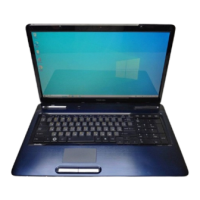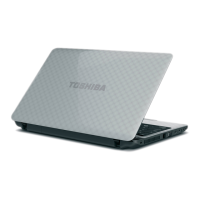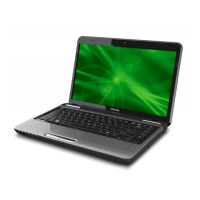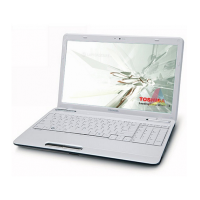
Do you have a question about the Toshiba Satellite L745 Series and is the answer not in the manual?
| RAM | Up to 8GB DDR3 |
|---|---|
| Optical Drive | DVD SuperMulti drive |
| Wireless | Wi-Fi 802.11 b/g/n |
| Processor | Intel Core i3/i5/i7 |
| Storage | 320GB HDD |
| Display | 14-inch HD (1366x768) LED-backlit |
| Graphics | NVIDIA GeForce 525M |
| Operating System | Windows 7 Home Premium |
| Battery | 6-cell Lithium-ion battery |
| LAN | 10/100 Ethernet |
| Webcam | Integrated webcam |
| HDMI | Yes |
| Ports | VGA |
| Bluetooth | Bluetooth 3.0 |
Explains formatting conventions used in the manual.
Details importance of proper ventilation to prevent overheating and damage.
Guidance on setting up a workspace for optimal computer performance and user comfort.
Information on preventing hand and wrist injuries from extensive keyboard use.
Precautions regarding prolonged physical contact with warm computer surfaces to avoid low-heat injury.
Explains protective earthing requirements for connected equipment and potential hazards.
Warnings against applying heavy pressure or impact that can damage computer components.
Advises on maintaining a distance from mobile phones to prevent audio system interference.
Refers to a separate manual for detailed safe and proper computer use information.
Lists essential hardware, documentation, and software items to check upon receiving the computer.
Provides basic information for using the computer, including setup and initial operations.
Explains how to access system recovery tools for startup problems and diagnostics.
Illustrates and describes the computer's front view when the display panel is closed.
Details the ports and slots located on the left side of the computer.
Describes the ports and connectors found on the right side of the computer.
Shows and identifies components located on the back of the computer.
Illustrates and explains the components on the underside of the computer, including battery lock.
Depicts and labels the components visible on the front when the display panel is open.
Explains the function of various system and keyboard LED indicators.
Describes the types of optical drives that may be installed in the computer.
Details the AC adaptor, its function, and voltage/frequency compatibility for power.
Describes the computer's hardware components like CPU, memory, and power.
Lists and explains pre-installed utilities and applications for system management and enhancement.
Describes optional hardware and accessories that can expand the computer's capabilities.
Explains the function and supported media types for the memory card slot.
Instructions on operating the Touch Pad for cursor control and gestures.
Details the function and usage of the built-in web camera for video recording and chat.
Explains how to use face recognition for logging into Windows and managing data.
Guides on loading, removing, and using CD/DVD/Blu-ray drives for playback and burning.
Provides instructions and precautions for writing data to various types of optical discs.
Explains how to use the VIDEO PLAYER for DVD and Blu-ray playback, including limitations.
Details the usage of WinDVD BD for Blu-ray playback, covering features and notes.
Offers tips for protecting and maintaining CDs, DVDs, and Blu-ray discs for longevity.
Covers audio control functions, including volume adjustment and system sounds.
Explains how to connect, disconnect, and configure the internal modem for telephone line communication.
Discusses wireless communication functions like LAN and Bluetooth, including setup and security.
Details how to connect and disconnect to a Local Area Network (LAN) using Ethernet.
Provides guidelines for safely handling, moving, and cleaning the computer to ensure longevity.
Explains the Sleep Utility for managing power settings and the Sleep and Charge function.
Describes how the computer manages internal temperature to prevent overheating and potential damage.
Explains the basic function of typewriter keys for inputting characters and symbols.
Details the twelve function keys and their programmed actions when pressed.
Explains how to use the FN key in combination with other keys to activate special features.
Lists specific key combinations for quick system configuration changes and feature control.
Describes Windows-specific keys like the Start button and application key for OS navigation.
Explains the numeric keypad overlay and its use for data input and cursor control.
Guides on generating ASCII characters using specific numeric keypad codes.
Details how AC adaptor connection and battery status affect computer operation and charge.
Explains how to interpret system indicators like Battery, DC IN, and Power status lights.
Covers battery types, usage, recharging methods, and handling precautions.
Explains how to set and manage user and supervisor passwords for computer security.
Guides on booting the computer and entering the user password for access.
Describes different power states like Shut Down, Hibernation, and Sleep modes.
Lists hotkeys for entering Sleep or Hibernation modes, referencing the Keyboard chapter.
Explains how to configure the computer to turn on/off automatically when the display panel is opened/closed.
Details the feature that automatically puts the system into Sleep or Hibernation mode when inactive.
Instructions on how to launch the TOSHIBA HW Setup program for system configuration.
Overview of the HW Setup window, its tabs, and buttons like OK, Cancel, and Apply.
Explains how to set or reset user passwords for power-on security within the HW Setup.
Allows customization of display settings for internal or external monitors.
Guides on modifying boot settings, including boot priority for devices.
Allows selection of system boot-up speed for faster startup or normal operation.
Configures the computer to automatically boot when the display panel is opened.
Enables or disables waking the computer from Sleep Mode using keyboard input.
Allows the computer to power on from shutdown via a network signal.
Feature to enable or disable the computer's built-in LAN connectivity.
Option to enable USB Legacy Emulation for compatibility with older operating systems.
Allows configuration of SATA interface settings for storage devices.
Provides guidelines for identifying and resolving computer problems effectively.
Offers simple checks for common issues like peripheral connection and driver loading.
Guides on how to interpret system clues like error messages, indicators, and noises to diagnose issues.
Lists common hardware and system areas where problems might occur.
Troubleshooting steps for issues when the computer fails to start properly.
Addresses problems that may arise from software or media issues, suggesting solutions.
Guides on checking hardware setup and configuration when software issues are ruled out.
Explains the automatic self-test during boot-up and how to interpret its results.
Troubleshooting for AC power and battery-related issues, including indicator checks.
Addresses computer shutdown due to overheating and how to resolve it.
Specific steps for troubleshooting AC power connection and adaptor issues.
Troubleshooting steps for battery not powering the computer or not charging.
Addresses issues related to the BIOS setting and system date/time being lost.
Troubleshoots common keyboard issues like keys producing numbers or garbled output.
Helps resolve display panel issues like no display or markings on the screen.
Troubleshooting steps for problems related to the hard disk drive, including boot issues.
Addresses issues with accessing or reading discs from the DVD Super Multi drive.
Troubleshoots problems related to accessing or reading discs from the Blu-ray drive.
Solves memory card errors like inability to write or read data.
Addresses issues with the mouse and Touch Pad not working or responding correctly.
Guides on troubleshooting USB devices that are not working or recognized by the computer.
Explains error scenarios related to memory module installation.
Helps resolve sound issues like no sound heard or annoying feedback noise.
Troubleshoots issues with external monitors not displaying correctly or not turning on.
Addresses modem problems like initialization failures, connection issues, or garbled data.
Troubleshoots LAN access issues, including Wake-up on LAN not working.
Helps resolve problems with accessing Wireless LAN networks.
Guides on troubleshooting issues with accessing Bluetooth devices.
Addresses HDMI output problems, specifically when no display appears on the monitor.
Explains how to resolve issues with the Recovery Media Creator not launching.
Provides information on how to contact TOSHIBA for additional technical assistance.
Offers advice on steps to take before contacting TOSHIBA support for assistance.
Lists the physical size specifications of the computer in millimeters.
Details operating and non-operating ambient temperature and humidity requirements.
Explains how the display controller interprets commands and manages screen resolution and colors.
Describes how video mode settings are configured via the Screen Resolution dialog.
Explains Wireless LAN compatibility and compliance with IEEE 802.11 standards.
Details Bluetooth interoperability and compliance with Bluetooth specifications.
Provides warnings about potential interference and health considerations when using wireless devices.
Discusses radio frequency energy emitted by wireless products and their safety for consumers.
Outlines radio frequency and safety standards compliance, with country-specific restrictions.
Specifies the minimum wire size requirement for AC power cords.
Specifies the minimum current rating requirement for AC power cords.
Lists various agencies that certify AC power cords and connectors for different regions.
Describes the application that monitors system functions like power, battery, and cooling.
Provides methods to start and enable the PC Health Monitor application.
Explains how to handle messages or alerts detected by the PC Health Monitor.
Advises that not all icons shown may apply to the specific computer model.
Discusses CPU performance variations based on operating conditions and configurations.
Explains requirements for 64-bit computing and potential compatibility issues.
Details how main system memory is used, including graphics allocation and OS limitations.
Explains factors affecting battery life and its gradual reduction over time.
Clarifies the definition of Gigabyte (GB) and factors affecting reported storage capacity.
Notes the natural deterioration of LCD brightness over time and AC vs. battery power impact.
Discusses GPU performance variations based on model, settings, and power mode.
Explains factors affecting wireless LAN transmission speed and range.
Mentions that copy protection standards may limit media recording or viewing.
Provides a list of common abbreviations used throughout the manual.











